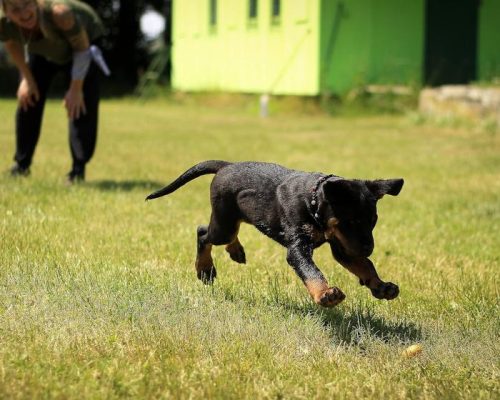The Labrador Retriever consistently rank as one of the most popular dog breeds in the United States and around the world. These sporting dogs have friendly demeanour, versatility, and suitability as family pets contributing to their widespread popularity among dog lovers of all ages and backgrounds.
Despite fluctuations in breed popularity, Labrador Retrievers and Golden Retrievers have maintained a steady presence at the top of the list, reflecting their enduring appeal and charm.
They are easy to train and can easily get along with other pets in the household. However, as with most pets, you should socialize your dog correctly from an early age.
History of the Labrador Retriever
We can trace the origins of the Labrador Retriever roots back to the rugged terrain of Newfoundland, where they were bred as versatile working dogs. This breed comes from a line of dog breeds that includes the St. John’s Water Dog.
St. John’s Water Dogs were renowned by breeders for their swimming prowess and retrieving abilities. However, this breed is now extinct.
The breed caught the attention of English sportsmen in the early 19th century, who recognized their talent for retrieving game birds. Furthermore, during those times fishermen used the Labrador Retrievers as trusted helpers, assisting them in retrieving nets and hauling in catches from the icy waters.
At the same time, Labrador Retrievers became prized for their natural retrieving instincts and exceptional hunting skills, particularly in retrieving waterfowl. In 1903, the Kennel Club of England officially recognized Labrador Retrievers as a distinct breed, solidifying their place in canine history.
Labrador Retriever: Physical Characteristics
Labrador Retrievers are known for their athletic build, friendly expression, and distinctive features. The adult Labradors typically weigh between 55 to 80 pounds and stand 21.5 to 24.5 inches tall at the shoulder. Labradors visually have a balanced and muscular build.
This dog boasts an otter tail, which serves as a powerful rudder while swimming. Furthermore, they have a double coat consisting of a dense, water-resistant outer layer and a soft, insulating undercoat.
When it comes to coat patterns and colours, Labradors come in three primary coat colours, each with its unique charm and appeal. The most common colours are black, chocolate and yellow.
Although the most common colour is black-coated Labs. There are, however, rare colour variations of the Labrador retrievers. In recent times, breeders have noted that the chocolate and silver-coated Labradors have gained popularity, adding variety to the breed’s coat palette.
Temperament and Personality Traits of the Labrador Retriever
The popular Labrador Retrievers are renowned for their friendly and outgoing demeanour. These traits make them excellent companions for individuals and families alike. Labradors thrive on human interaction and have unwavering loyalty and affection towards their owners.
Labradors have a playful and sociable nature and they enjoy the company of people and other animals, making them ideal family pets and therapy dogs.
They are highly intelligent and eager to please, making them a joy to train. Labs possess keen problem-solving skills, allowing them to quickly learn new tasks and adapt to various training scenarios.
You can easily motivate this dog with positive reinforcement and praise. This makes them responsive to training and eager to participate in activities with their owners.
Versatility of Labrador Retrievers
This versatility is very broad, you can essentially use it as a pet for kids, a hunting dog, or a therapy dog. Labrador Retrievers excel in a wide range of working roles, owing to their intelligence, athleticism, and strong work ethic.
As we mentioned earlier, they have an instinct for retrieving games. This instinct makes them prized hunting companions for waterfowl and upland game birds.
A Labrador Retriever’s keen sense of smell and strong tracking abilities make them valuable assets in search and rescue missions. It is not uncommon to see the police use Labs to locate missing persons or provide comfort to those in distress.
Furthermore, they can play an essential role as service and assistance dogs. Labs can provide invaluable support and companionship to individuals with disabilities and special needs. To add to their impressive versatility resume, you can train Labradors as guide dogs.
They can easily assist visually impaired persons in moving around their surroundings safely and independently. Labradors’ gentle nature and intuitive understanding make them ideal therapy dogs. They can offer comfort and companionship to those who need their therapeutic presence.
Health and Longevity of a Labrador Retriever
While Labrador Retrievers are generally healthy, they are susceptible to certain genetic and hereditary health conditions. Labradors are prone to hip and elbow dysplasia, which can lead to joint pain and mobility issues if left untreated.
Labs are also prone to Progressive Retinal Atrophy (PRA). PRA is a degenerative eye disease that can cause vision loss in this breed.
However, with proper care and nutrition, Labrador Retrievers can enjoy a relatively long and healthy life. They live between 10 to 12 years, although some may live longer with proper veterinary care and a healthy lifestyle.
It is also important to note that some factors can significantly affect the health and longevity of this breed. Such factors include genetics, diet, exercise, and preventive healthcare measures.
Exercise and Activity Needs
Labrador Retrievers are energetic and active dogs that require regular exercise to maintain their physical and mental well-being. They require at least 30 to 60 minutes of daily exercise including walks, runs, and interactive play sessions.
You could use swimming, fetch, hiking, and agility training to keep your Labrador physically and mentally stimulated. In addition to physical stimulation, Labradors require mental stimulation because they can get easily bored. This is due to their high energy and activity levels.
To prevent boredom and behavioural issues, engaging them in activities such as puzzle toys, obedience training, and interactive games can help satisfy Labradors’ mental and intellectual needs. It challenges their problem-solving skills and keeps their minds sharp and engaged.
Grooming and Maintaining a Labrador Retriever
Labrador Retrievers have a short, dense coat that requires regular grooming to keep it healthy and free of mats and tangles. Weekly brushing with a slicker brush or grooming mitt helps remove loose hair and distribute natural oils, keeping the coat shiny and healthy.
Labradors shed moderately year-round, with heavier shedding occurring during seasonal changes. Regular brushing helps minimize shedding and prevents excessive hair accumulation in the home. Proper ear and dental care are also essential components of Labrador Retrievers’ grooming and maintenance routines.
Labradors’ ears should be checked and cleaned regularly to prevent wax buildup and infections. Additionally, regular brushing with a dog-specific toothbrush and toothpaste helps maintain good oral hygiene and prevents dental issues.
Routine ear cleaning and dental care reduce the risk of ear infections, dental plaque buildup, and periodontal disease, ensuring Labradors’ overall health and well-being.
Training and Obedience
Labrador Retrievers are highly trainable and excel in basic obedience training. Teaching this breed basic commands such as sit, stay, come, and heel establishes clear communication. At the same time, it also fosters a strong bond between dogs and their owners.
Advanced training activities such as retrieving, agility courses, and obedience trials challenge Labradors’ physical and mental abilities. It helps to provide them with stimulation and enrichment.
It would be best to use positive reinforcement methods, such as treats, praise, and rewards. This easily motivates Labradors to learn and obey commands, making training sessions enjoyable and effective.
Socialization and Behavior
Early socialization is crucial for all dog breeds not only Labrador Retrievers. It can help to develop them into well-rounded and well-behaved dogs. Socializing your Labrador puppies with various people, animals and environments helps build confidence. It also reduces the likelihood of fear and aggression later in life.
Although Labrador Retrievers are generally friendly and well-behaved, they may exhibit certain behavioural issues that require attention and training. It is not uncommon for Labs to experience separation anxiety when left alone for extended periods which often leads to destructive behaviours such as chewing and digging.
However, consistent training, positive reinforcement, and appropriate management techniques can effectively address and prevent common behavioural problems in this breed. It also ensures a harmonious relationship between Labs and you, their owners.
Nutrition and Diet
Proper nutrition is essential for Labrador Retrievers’ overall health and well-being, providing them with the energy and nutrients they need to thrive.
Labradors benefit from a balanced diet consisting of high-quality dog food formulated to meet their nutritional needs. It would be best to avoid fillers and artificial additives.
Labradors have a hearty appetite and may be prone to obesity if overfed or given too many treats. Portion control, regular exercise, and feeding a balanced diet help prevent weight gain and promote a healthy body condition.
Adult Labradors typically benefit from two meals a day, spaced evenly apart, to maintain energy levels and prevent hunger between meals. Feeding guidelines provided by pet food manufacturers can help determine appropriate portion sizes based on age, weight, and activity level.
While treats can be used as rewards during training and bonding, it’s essential to moderate their intake to prevent excessive calorie consumption and maintain a healthy weight. Opt for nutritious treats made with wholesome ingredients and avoid feeding human foods that may be harmful to dogs.
Conclusion
Labrador Retrievers are much more than just friendly family pets; they are intelligent, loyal, and versatile companions with a rich history and remarkable temperament.
Whether serving as hunting partners, service dogs, or beloved family members, Labrador Retrievers continue to capture the hearts of dog lovers around the world.
As we celebrate their history, facts, and temperament, let us appreciate the unique bond between humans and Labradors and the joy they bring to our lives.






